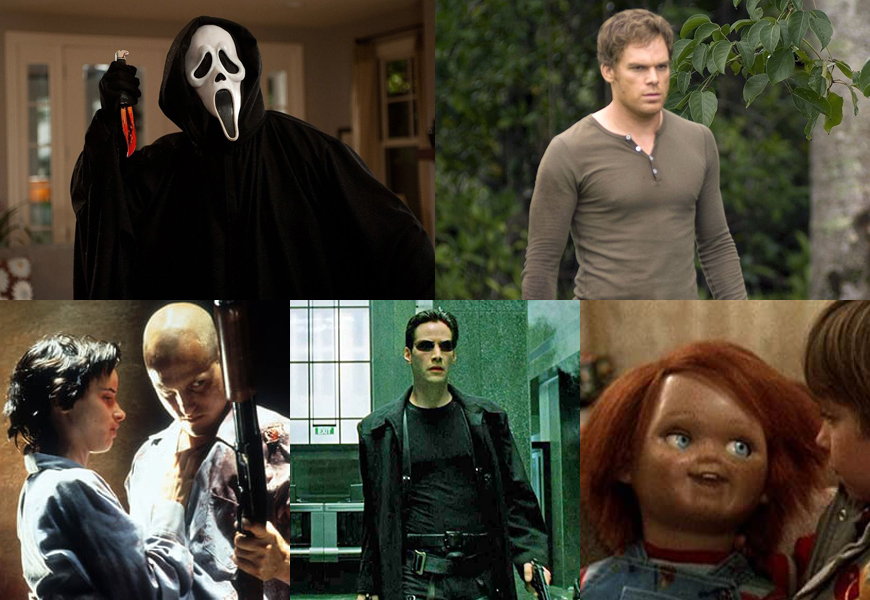These cases are examples of obsessive fandom turning deadly.
From Leatherface in The Texas Chainsaw Massacre to Hannibal Lecter and Buffalo Bill in Silence of the Lambs, there are plenty of examples of fictional characters who were inspired by real-life serial killers. But what happens when someone is inspired by a violent movie and decides they want to recreate it IRL? A copycat murder is rarely, if ever, an exact replica of the source material. Instead, the killer will pick and choose certain elements, such as motivation, technique, or setting, that appeal to them. According to Psychology Today, recreating a fictional crime makes it easier for the perpetrator to harm others by psychologically separating from their own identity and “temporarily taking on a persona or character of someone else”.
While some killers have no intention of ever getting caught, others kill for notoriety and fame—and what better way to get attention than copying a well-known fictional crime? Here are just a few fictional works that have earned the unfortunate reputation of being inspiration for real-life killers.
Scream
Wes Craven’s late 90s slasher franchise was notable for its tongue-in-cheek meta take on the genre. It was a box office and critical success making the killer, known as Ghostface, recognizable all over the world. In 2001, 24-year-old Thierry Jaradin from Belgium stabbed 15-year-old Alisson Cambier 30 times while wearing a Ghostface costume. Jaradin later confessed that he was inspired by the film franchise, was convicted of first-degree murder and sentenced to life in prison.
In 2006, 16-year-old Cassie Jo Stoddart was house sitting for her aunt and uncle. Two of her classmates—and friends—Brian Draper and Torey Adamcik came over to watch a movie but left halfway through. Unbeknownst to Cassie, they left a backdoor unlocked so they could return later, which is when Draper and Adamcik attacked Cassie and stabbed her over 30 times. During their trial, it came out that the murder was premeditated and the duo video taped their plan. Draper claimed to be inspired by the Columbine shooters, and Adamcik was inspired by the Scream franchise. They were both convicted of first-degree murder and sentenced to life in prison.
Dexter
Edmonton’s Mark Twitchell always wanted to be a filmmaker but instead of focusing his energy on that, he became obsessed with the Showtime series Dexter, specifically the title character, a fictional blood spatter expert who has a secret life as a serial killer. In 2008, Twitchell posed as a woman on dating site Plenty of Fish and convinced 38-year-old John Atlinger to meet in person. Twitchell had outfitted his garage into a “kill room”, covering the walls and floor in plastic the way Dexter does on the show.
Once Atlinger arrived, Twitchell bludgeoned and stabbed him to death before dismembering him and dumping his remains into a storm sewer. It wasn’t long before Twitchell was arrested and charged with first-degree murder. During the trial, Twitchell’s strong interest in the television series Dexter was noted repeatedly, and media outlets started referring to him as the “Dexter Killer”. Twitchell was found guilty and sentenced to 25 years without parole.
Natural Born Killers
In Oliver Stone’s Natural Born Killers, married couple Mickey and Mallory Knox (played by Woody Harrelson and Juliette Lewis) go on a killing spree across several states, murdering anyone who gets in their way. The film is a criticism of how real-life violence is glorified for entertainment, making people like Mickey and Mallory into cult-like heroes. Unfortunately, the themes were a little too on the nose and ended up serving as inspiration for a number of real-life murders.
Just to name a few: the Columbine shooters, Eric Harris and Dylan Klebold, were reportedly big fans of the movie and used “NBK” as code for their plans for the shooting. 15-year-old Jason Lewis murdered his parents as part of a plot between him and three friends to kick off a cross country killing spree inspired by the Knoxes. Jeremy Allen Steinke and Jasmine Richardson murdered her parents because they wouldn’t let them see each other—for good reason, he was 23 and she was 12. His friends also reported Steinke talking about “going all Natural Born Killers on her family.”
Not only was Natural Born Killers inspiration for would-be criminals, but it was also inspired by real-life criminals. Charles Starkweather and Caril Fugate were only teenagers when they went on a multi-state killing spree, murdering ten people before they were apprehended.
The Matrix
Arguably one the biggest movie franchises of all time, The Matrix operates under the premise that the world is actually one big computer-generated simulation. If that’s true, can you really be held responsible for any crimes committed? More than a couple people took this idea and ran with it—directly into their murder trial. In 2003, 19-year-old Joshua Cookie murdered his adoptive parents with a shot gun while dressed like Neo. His planned defence involved psychologist testimony that Cooke truly believed he lived in a virtual reality. He ended up abandoning his “Matrix defense” and pleading guilty instead.
Before Cooke, Washington snipers Lee Boyd Malvo and John Allen Muhammad killed 10 people over a three-week period. Malvo, who was just a teenager at the time, claimed The Matrix was the key to understanding him and his motives. While Malvo’s team originally planned on citing the movie as part of an insanity defence, they ended up focusing more on video games instead. A few people did end up using the so-called Matrix defence and were successful—in that they ended up in an institution instead of prison. The documentary “Glitch in the Matrix” explores why the film franchise has such an impact on certain types of people and how ideas introduced by The Matrix have been utilized in the courtroom.
Child’s Play
The Child’s Play franchise centers around Chucky, a child’s doll that becomes possessed by the spirit of a serial killer and starts slaughtering people. While the films were clearly not meant for young audiences, we can all remember watching movies we probably shouldn’t have when we were younger. The 1993 murder of 2-year-old James Bulger by Jon Venables and Robert Thompson, who were both 10, shocked the UK and the world. The two older boys kidnapped Bulger before torturing and murdering him. Specifcally, they beat him and threw paint in his face—which is how the possessed Chucky doll is killed in Child’s Play 3.
During their trial, it was revealed that Jon Venables may have watch Child’s Play 3 when the family rented it a month before the murder. Venables and Thompson were found guilty of murder and in his judgement the judge said that exposure to violent movies may have influenced the behaviour of the boys. Authorities and psychologists connected to the case have since said there is no reason the believe Child’s Play inspired the boys to kill.
While Bulger’s murder may or may not have been connected to Chucky, the film has a connection to another case. The murder of Suzanne Capper, happened around the same time but got considerably less media attention. It was reported that Suzanne was forced to listen to a recording of Chucky’s trademark line: “I’m Chucky, wanna play?” while she was tortured. Suzanne was miraculously able to give police the names of the six people who attacked her before she died and they were all found guilty of various charges including murder, false imprisonment and conspiracy to cause grievous bodily harm.












